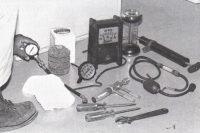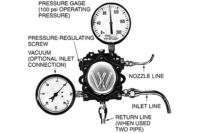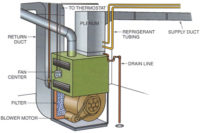Bob is a service technician who is well trained and nationally certified. However, he has sometimes suffered from the same confusion that all technicians occasionally do — the facts that he gathers may or may not point to the obvious cause of the problem or the best solution. But Bob has had something that no one else has. He recalled his long-time HVACR mentor and imagines him accompanying him as “Btu Buddy,” someone who reminded him to take time to stop and think before rushing to judgment, helping keep him on the right track, even with facts that are confusing.
Now, Bob’s company has promoted him to help train a new employee, right out of a school specializing in HVAC, just like Bob was. Bob is now Tim’s Btu Buddy. Tim is anxious to travel with Bob. Tim realizes that he is right out of school, with the theory and lab work that he accomplished in school, but still needs help. He knows that he worked with many of the components of the systems in the school, under ideal conditions with good light and air conditioning. Now it is into the field, sometimes under the house with poor lighting, or out on the rooftop in the sun, where the real action is. He is naturally and normally reluctant, but he has Bob to help guide him.
Bob and Tim were on their way to a service call at a store that has a frozen heat pump outdoor unit. It is late in the season and the customer called and said, “Our outdoor unit is frozen solid with ice.”
Bob and Tim arrived at the business, where the outdoor unit was located in back of the store. Tim said, “Sure enough, that unit is frozen solid.”
They went in and talked to the store owner and he explained that when he arrived today the unit was frozen and it looked good when he left yesterday.
It wasn’t a cold night last night. It got down to about 35°F and it was about 45° when Bob and Tim arrived.
Bob said, “Let’s put the unit through a forced defrost. Two conditions must be satisfied for the unit to go into defrost. The circuit board timer must time out and the coil must be down to a temperature that would promote freezing. This is often about 26°. I am going to jump out the sensor circuit. Then I am going to force the timer to close the board contacts by running the clock faster. If it doesn’t go into defrost, the board is bad; probably the board’s defrost relay is not functioning. If it goes into defrost, we will check to see if the sensor contacts are closing.”
They ran the tests and determined the board was bad. Since they had to get a new board, Bob decided to get a new sensor, since it was not very much more and was subject to failure.
Bob then said, “Examine the contactor contacts and see what they look like.”
Tim looked at the contacts and said, “They are really pitted. It looks like it is time to change them also.”
They took all of the information off of the unit nameplate and went to the supply store. It was all the way across town and took over an hour to pick up the parts and get back to the job.
Tim took a photo of the connections on the old circuit board and removed it from the control panel. He then removed the new circuit board from the box and noticed that it was not the same board. In fact, it was too big to fit into the control box.
Tim then said, “I think they gave us the wrong board.”
Bob looked at it and said, “They sure did. Let’s look at the data that we took from the unit nameplate and make sure we got all of the numbers correct.”
They examined them and they were right. The supply house had just pulled the wrong part.
Tim said, “I am going to take a photo of this old board and the nameplate so when we go back to the supply house we will be sure to get the correct board (Figures 1 and 2).”
They told the customer what was going on and made sure the thermostat was set to emergency heat so the building would remain comfortable and left for the supply house.
When they got to the supply house, they showed the problem to the counter man and he did some research and said, “It was my fault. I picked up the wrong box.”
He went to the back and returned with the correct box and opened it and compared the part with the photo that Tim had taken.
Tim said, “This is the correct board.”
The counter man apologized and said, “I am sorry about this. I know that it cost you and your company a lot of time to make a trip back across town. I will always double check from now on. I have learned a lesson.”
Bob and Tim went back to the job and replaced the parts and started the system back up in normal heat pump operation.
Bob said, “Let’s run the system through defrost and get this ice off of the coil. It may take more than one forced defrost to clean up this coil. It is pretty loaded with ice. I am going to run the timer forward without jumping out the defrost sensor. The coil should be cold enough for the sensor to be calling for defrost.”
Bob advanced the timer and the unit went into defrost. They watched it through the defrost cycle and Tim said, “I believe the coil is clear enough. I believe it will operate normal now.”
Bob said, “I agree. Let’s look and see if the coil needs cleaning.”
They examined the coil and it had a lot of trash on one side of the coil. So they shut the unit down and removed the fan from the top and sprayed the coil with coil cleaner and flushed it from the inside to the outside in the opposite direction of the airflow.
Tim commented, “There was a lot of debris in the core of the coil. It always surprises me to see how much trash gets all the way into the core of a coil.”
Bob then said, “Let’s oil the fan motor before we put it back in the unit. Then let’s put it back together and start it back up. While it is running lets go inside and change the filter and call this a complete service call.”
They started the unit and changed the air filter inside. It was really dirty, so Bob suggested they shut it down and check the indoor coil to see if it was dirty. It looked good, so they restarted the unit and talked to the owner and explained what they had done and why. They also presented him with the bill for the service call.
When they were leaving the job, Tim said, “I learned a lesson, too. I really should have taken a photo of the circuit board and unit nameplate first thing and used them at the supply house to make sure I got the right parts. We have this modern technology to back us up.”
Bob added, “We really could have taken those photos and emailed them to the supply house and not have to wait at the counter to get the parts. They could have been ready when we got there. While we were riding across town, one was driving and the other could have been ordering the parts.”
Tim then said, “I suppose we will finally learn to take advantage of our resources and become really efficient. The more efficient we are, the more money the company and we will make.”
Publication date: 4/20/2015
Want more HVAC industry news and information? Join The NEWS on Facebook, Twitter, and LinkedIn today!












